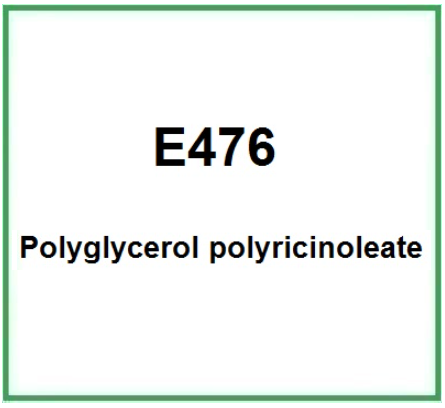E476 (Polyglycerol polyricinoleate) is a chemical compound obtained from polyglycerol and castor oil.
The name describes the structure of the molecule
- Polyglycerol - Refers to a molecule derived from the polymerization of glycerol.
- Polyricinoleate - Indicates the presence of multiple ricinoleate groups, derived from ricinoleic acid, which is a fatty acid present in castor oil.
Description of raw materials used in production
- Glycerol - A simple, colorless compound that can be sourced from vegetable fats and oils.
- Castor oil - A source of ricinoleic acid, from which ricinoleate is derived.
Synthesis process
- Polymerization - Glycerol is polymerized to form polyglycerol.
- Esterification - The polyglycerol reacts with ricinoleic acid (or its derivatives) through an esterification process to form polyglycerol polyricinoleate.
- Purification - Any impurities are removed to yield a high-purity product.
From where it is extracted
Different strategies for the solvent-free enzymatic production of polyglycerol polyricinoleate (PGPR) were explored in an attempt to simplify and improve the process. Besides the conventional procedure (obtaining polyricinoleic acid, followed by its esterification with polyglycerol), two alternative methods are proposed: a) reversing the synthesis order, i.e. esterification of polyglycerol with ricinoleic acid and then the condensation of ricinoleic acid with the previously obtained polyglycerol ester; and b) the enzymatic synthesis of PGPR in a single-step process (1).
What it is used for and where
Polyglycerol Polyricinoleate, also known as PGPR, is a plant-based emulsifier often used in the food industry, especially in chocolate production. PGPR reduces the viscosity of chocolate, allowing for smoother processing.
Food
Ingredient included in the list of European food additives as E476 as an emulsifier and stabiliser.
The esterification of condensed castor oil fatty acids with polyglycerol gives a powerful water-in-oil emulsifier which is used by the food industry in tin-greasing emulsions and as an emulsifier with lecithin in chocolate couverture and block chocolate (2).
Applications
- Chocolate Production - PGPR is used as an emulsifier in chocolate to improve its flow properties. This can reduce the amount of cocoa butter required, making chocolate production more cost-effective.
- Emulsifying Agent - In cosmetic products, PGPR can help mix water-based ingredients with oil-based ones, creating a uniform texture.
- Texture Improvement - In some food formulations, PGPR can enhance the product's consistency.
- Solubilizing Agent - Can help solubilize ingredients that otherwise wouldn't mix easily.
Safety
A series of toxicology studies was conducted in the 1950s and 1960s to investigate the toxicity of ADMUL WOL, a brand of polyglycerol polyricinoleate (PGPR). A component of these investigations included studies in human subjects. During 1964 and 1965, PGPR was fed to 19 human volunteers whose diet contained constant levels of fat and protein. Up to 10 g/day PGPR was fed to each volunteer in soups, cakes and toffee bars for 2 weeks. Pre-exposure normal values of biochemical parameters were established. Fat balance tests confirmed that digestion and absorption of PGPR took place. No consistent effect of PGPR on the various biochemical parameters was observed, nor had PGPR any toxic effect on liver and kidneys. The consumption of PGPR by humans produced no adverse effects. The quantities consumed, up to 10g/day, was equivalent to approximately 63 times the estimated maximum per capita mean daily intake by man of 2.64 mg kg body weight/day. It is therefore concluded from this study that the consumption of ADMUL WOL, a brand of PGPR, has no adverse effects in man (3).
Acceptable daily intake in the European Union: 7.5 mg/kg body weight, while in the U.K. it is limited to 2.64 mg/kg body weight. Below these levels there would be no adverse effects on tolerance, liver and kidney function, and fat balance (2).
- Molecular Formula C21H42O6
- Molecular Weight 390.561 g/mol
- CAS 68936-89-0
Synonyms :
- polyglycerol polyricinoleate
- Ricinoleic acid, ester with polyglycerol
- (Z,12R)-12-hydroxyoctadec-9-enoic acid; propane-1,2,3-triol
- 1,2,3-Propanetriol, homopolymer, (9Z,12R)-12-hydroxy-9-octadecenoate
- 68936-89-0
- AC1O5W2M
- SCHEMBL716804
- POLYGLYCEROL POLYRICINOLEATE
- LS-194149
References_____________________________________________________________________
(1) Ortega-Requena S, Gómez JL, Bastida J, Máximo F, Montiel MC, Murcia MD. Study of different reaction schemes for the enzymatic synthesis of polyglycerol polyricinoleate. J Sci Food Agric. 2014 Aug;94(11):2308-16. doi: 10.1002/jsfa.6559. Epub 2014 Feb 22.
(2) Wilson R, Van Schie BJ, Howes D. Overview of the preparation, use and biological studies on polyglycerol polyricinoleate (PGPR). Food Chem Toxicol. 1998 Sep-Oct;36(9-10):711-8. Review.
(3) Wilson R, Smith M. Human studies on polyglycerol polyricinoleate (PGPR). Food Chem Toxicol. 1998 Sep-Oct;36(9-10):743-5.
![]() E476
E476 





